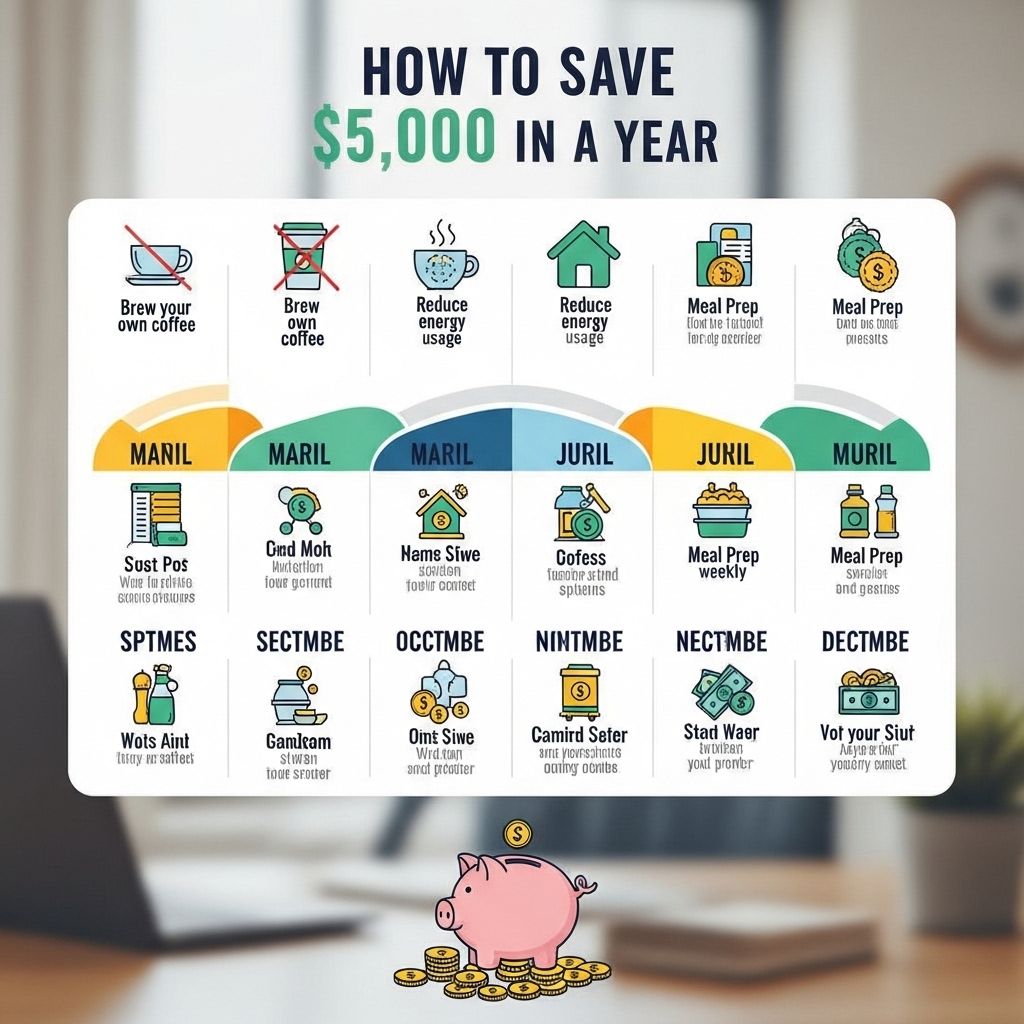Saving money can often feel like a daunting task, but with the right strategies and a bit of determination, it can be quite achievable. If you’re looking to save $5,000 in a year, you can break down your goal into manageable monthly savings, create effective budgeting strategies, and find ways to cut unnecessary expenses. In this article, we’ll explore various methods you can employ to meet your savings goal while also maintaining your lifestyle.
Table of Contents
Setting the Stage for Savings
The first step towards saving $5,000 in a year is to assess your current financial situation. Understanding your income, expenses, and spending habits will help you identify where you can cut back and how much you can realistically save each month.
Assessing Your Finances
- Calculate Your Monthly Income: Include all sources of income such as your salary, side gigs, or passive income.
- Track Your Expenses: List all your monthly expenses, both fixed (rent, utilities) and variable (groceries, dining out).
- Identify Areas to Cut Back: Look for non-essential expenses that can be reduced or eliminated.
Creating a Savings Plan
Once you have a clear understanding of your finances, it’s time to create a savings plan that fits your lifestyle.
Saving Strategy
To save $5,000 in a year, you need to set aside approximately $416.67 each month. Here are some strategies to help you achieve this:
- Automate Your Savings: Set up an automatic transfer from your checking account to your savings account each month.
- Use a Dedicated Savings Account: Open a high-yield savings account specifically for your savings goal to earn interest.
- Set Monthly Goals: Break down the $5,000 into smaller, more manageable monthly goals.
Utilizing the 50/30/20 Budgeting Method
A popular budgeting method is the 50/30/20 rule, which divides your income into three categories:
| Category | Percentage | Purpose |
|---|---|---|
| Needs | 50% | Essential expenses such as housing, food, and transportation. |
| Wants | 30% | Non-essential expenses such as entertainment and dining out. |
| Savings | 20% | Funds for savings, investments, and debt repayment. |
Cutting Unnecessary Expenses
Finding ways to save money often comes down to cutting unnecessary spending. Here are several practical tips to reduce costs:
Evaluate Subscription Services
- Review your subscriptions (streaming services, magazines, etc.) and cancel any you don’t use regularly.
Cook at Home
Eating out can quickly drain your budget. Consider these approaches:
- Plan your meals for the week and create a shopping list.
- Prepare larger portions and save leftovers for lunch.
- Experiment with cooking simple, cost-effective meals.
Embrace Frugality
Adopting a frugal mindset can aid in cutting costs:
- Buy in Bulk: Purchase non-perishable items in bulk to save money over time.
- Use Coupons and Discounts: Take advantage of coupons, loyalty programs, and seasonal sales.
- Limit Impulse Purchases: Wait 24 hours before making any non-essential purchases.
Increasing Your Income
If cutting expenses isn’t enough to reach your savings goal, consider finding ways to boost your income:
Side Hustles
Explore different side jobs or freelance work that can help supplement your income:
- Freelancing in your area of expertise.
- Driving for a rideshare service or delivering food.
- Participating in online surveys or remote gigs.
Sell Unused Items
Generate extra cash by decluttering your home:
- Identify items you no longer use or need.
- Sell them on platforms like eBay, Facebook Marketplace, or a garage sale.
Staying Accountable and Motivated
Staying on track with your savings goal requires accountability and motivation. Here are some tips:
Use Savings Apps
Consider using financial apps that help track your savings progress:
- Budgeting Apps: Tools like Mint or YNAB can help manage your transactions.
- Savings Apps: Apps like Qapital or Digit automate saving small amounts based on your spending.
Visualize Your Goal
Keeping your goal in sight can motivate you to stick to your plan:
- Create a vision board displaying what the savings will be used for.
- Set up a savings thermometer to visually track progress toward your $5,000 goal.
Conclusion
Saving $5,000 in a year may seem like a big undertaking, but with a structured plan, discipline, and smart financial choices, it is entirely achievable. Whether you decide to cut back on expenses, increase your income, or a combination of both, the key to success lies in your commitment to your savings goal. Start today, track your progress, and watch your savings grow!
FAQ
How can I save $5,000 in a year?
To save $5,000 in a year, you can set aside approximately $417 each month. Create a budget, cut unnecessary expenses, and consider setting up an automatic transfer to your savings account.
What are some effective budgeting tips for saving money?
Effective budgeting tips include tracking your income and expenses, identifying areas to cut back, setting specific savings goals, and sticking to a monthly budget.
Are there any apps that can help me save money?
Yes, there are several apps designed to help you save money, such as Mint, YNAB (You Need A Budget), and Digit, which can automate savings and help you track your spending.
How can I increase my income to save more?
To increase your income, consider taking on a part-time job, freelancing, selling unused items, or asking for a raise at your current job.
What are some common expenses I can cut to save money?
Common expenses to cut include dining out, subscription services, impulse purchases, and unnecessary shopping. Evaluate your spending habits for more savings opportunities.
Is it realistic to save $5,000 in a year?
Yes, saving $5,000 in a year is realistic with dedication, a solid budget, and consistent saving habits. It requires commitment but is achievable for most people.









